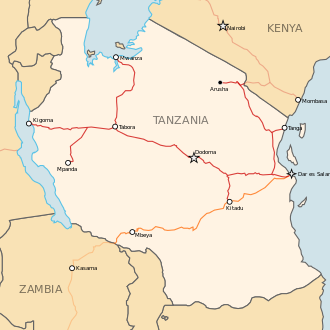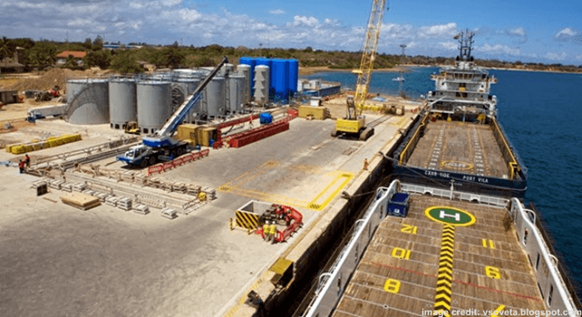2.1 Tanzania Port Assessment
The Republic Tanzania has three main sea ports namely, Dar es Salaam, Tanga and Mtwara ports. Other smaller sea ports include Kilwa, Lindi, Mafia, Pangani and Bagamoyo. There are also lake ports in Lake Victoria, Lake Tanganyika and Lake Nyasa. On Lake Victoria, there is Mwanza North and South ports, which is the main port on the Tanzanian side, and Bukoba, Musoma, Kemondo Bay and Nansio ports. Lake Tanganyika counts to ports in Tanzanie, Kigoma and Kasanga. Finally, on Lake Nyasa there are Itungi, Mbamba Bay, Kiwira, Liuli and Manda ports that ensure the ship services. Zanzibar is served by Malindi port in Stone Town.
The ports are managed by Tanzania Ports Authority (TPA), governmental agency established on 15 April 2005. It regulates and licenses port and marine services and facilities. It manages vessel traffic in the port while ensuring safety and security. The authority also operates a system of ports serving the Tanzania hinterland and the landlocked countries of Malawi, Zimbabwe, Zambia, Democratic Republic of Congo (DRC), Burundi, Rwanda and Uganda. In Zanzibar, the Zanzibar Port Corporation (ZPC) takes the TPA’s roles and responsibilities.
For information on Tanzania Port contacts, please see the following link: 4.4 Tanzania Port and Waterways Company Contact List
Tanzania, United Republic of - 2.1.1 Port of Dar es Salaam
Port Overview
Dar es Salaam is the principal port of Tanzania. It is the main cargo gateway not only for the Tanzanian hinterland and the Great Lakes region but also for landlocked neighbouring countries in east and central Africa such as Burundi, the Democratic Republic of Congo (DRC), Malawi, Rwanda, Uganda and Zambia
The port of Dar es Salaam is one of East Africa's leading freight gateways – a growing entry and exit of goods for local market and to many landlocked countries across East and Central Africa. The port is the Indian ocean entry point of a complex logistics network stretching much of central Africa. The port handles about 95 percent of Tanzania International trade across 12 deep-water berths. Tanzania Port Authority (TPA) operates all berths since January 2023. (TPA Handbook, 2023).
The port is accessible via 3-5km entrance channel that can allow vessels of up to 305 meters LOA and 265 meters breadth with a depth of 15.5 meters at Chart Datum. The port has a total quay length of 2.6 km with 12 Berths at Main Quay plus a Single Buoy Mooring (SBM) and a dedicated berthing area for coastal vessel at the lighterage Quay. Berths number 0 to11 has a depth between 10.2 and 15.5 meters for general cargo vessels. Berths No. 8 to 11 have an average depth of 11.0 meters and are mainly dedicated to container vessels. (TPA Handbook, 2016).
The port also has Grain Terminal facility (silos with storage capacity of 30,000 mt).
TPA is implementing a number of major projects including the Dar es Salaam Maritime Gateway Project (DMGP) which will allow the reception of larger vessels. Port modernization projects include strengthening and deepening of berths 1-7 and RORO terminal, dredging of entrance channel, turning circle and harbour basin, strengthening and deepening 8-11, and construction of a new terminal jet
Port website https://www.ports.go.tz/index.php/en/ports/ports
Key port information may also be found at: http://www.maritime-database.com
|
Port Location and Contact |
|
|---|---|
|
Country |
Tanzania |
|
Province or District |
Temeke |
|
Nearest Town or City with Distance from Port |
Dar es Salaam Located in the city |
|
Port's Complete Name |
Port of Dar es Salaam |
|
Latitude |
-6.82583333 |
|
Longitude |
39.30638889 |
|
Managing Company or Port Authority |
Tanzania Ports Authority (TPA) |
|
Management Contact Person |
Plasduce Mkeli Mbossa Director General, TPA Bandari Road PO Box 9184, Dar es Salaam Tanzania Tel: +255 22 2116250 Fax: +255 22 2130390 |
|
Nearest Airport and Airlines with Frequent International Arrivals/Departures |
Julius Nyerere International Airport, Dar es Salaam
International carriers: Air Zimbabwe, Airlink, As Salaam Air, Egyptair, Emirates, Ethiopian Airlines, Ewa Air, Flightlink, Fly540, Flydubai, Kenya Airways, KLM, LAM Mozambique Airlines, Malawian Airlines, Oman Air, Precision Ai, Qatar Airways, RwandAir, Saudia, Tropical Air, Turkish Airlines, Uganda Airlines, ZanAir These airlines fly to a variety of destinations, including Europe, the Middle East, Africa, and Asia. Please note that this list is not exhaustive and may change over time. It is always best to check with the airline directly to verify their current schedule and destinations. |
Port Picture
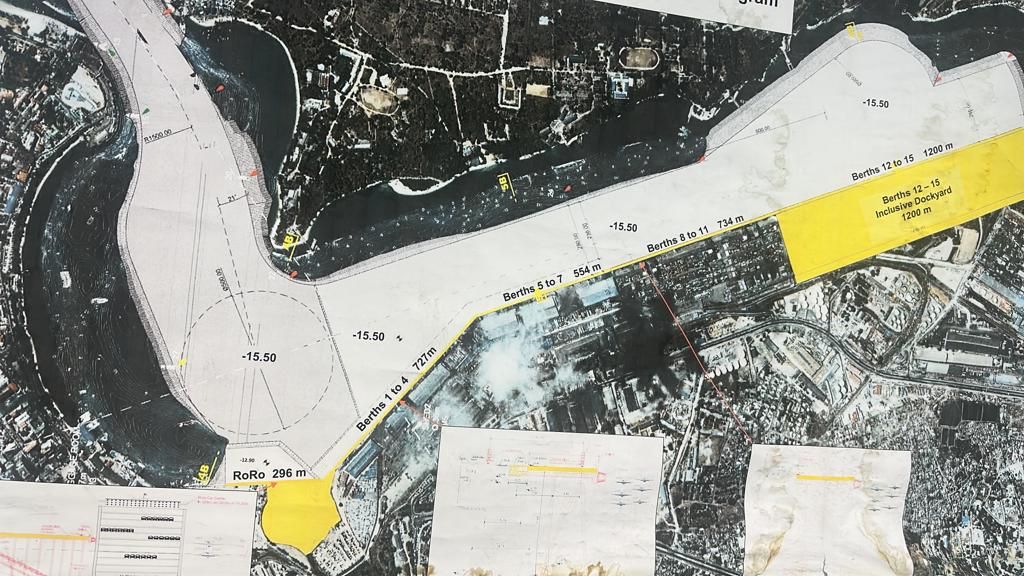
- General cargo Berth (0-5) for break bulk, dry bulk and one RORO berth (0) to handle vehicles.
- Container Terminal Berths (Berth 5 -11)
- Grain Terminal facility (silos with storage capacity of 30,000 tons). Inland Container Deposits (ICDs) facilities with the capacity of 24,300 TEUs and CFs with the capacity of holding 6,000 vehicles at once.
- A 150,000 MT Single Point Mooring (SPM) – for handling refined and crude oil.
- Kurasini oil Jetty (KOJ) for handling refined products (tanker size 45,000MT for KOJ1 and 5,000 tons for KOJ2)
Description and Contacts of Key Companies
The Tanzania Ports Authority (TPA) is a government entity, established by the Ports Act No. 17 of 2004, TPA is currently the sole operator of the facilities in Dar es Salaam port. TPA performs the role of landlord and operator with the main functions of promoting the use, development and management of the ports and their hinterlands. The Authority can and has in the past licensed and issued concessions for port services in Dar es Salaam.
For more information on port contacts, please see the following link: 4.4 Port and Waterways Companies Contact List.
Port Performance
Tanzania is a natural economic hub and gateway to east and central Africa, with one of Africa's busiest deep seaports and borders on eight nations. The Dar es Salaam port provides a gateway for 90% of Tanzanian trade and is also the access route to six landlocked countries including Malawi, Zambia, Burundi, Rwanda, and Uganda, as well as DRC.
A World Bank assessment published in 2013, the cost caused by inefficiencies at the Dar es Salaam port in 2012 was projected to be $ 1.8 billion for the Tanzanian economy and $ 830 million for neighbouring nations that relied on the facility.
The World Bank estimates that the losses amounted to 7% of Tanzania's yearly GDP. Due to rising port prices, Tanzanians and other East Africans had to pay more for imported commodities such as petroleum, cement, fertilizer, and medications.
Delays in accessing berths appear to be lessening, however container vessels were queuing for an average of 10 days (up to a maximum of 25 days in some situations) to get a berth in the port. Delays are worsened by dock operational inefficiencies and a shortage of storage, which increase the time required to unload and load a container ship, as well as insufficient synergy among key actors. The entire procedure takes days to complete, and space in the terminals is limited. As a result, the containers are frequently transported to an Inland Container Depot (ICD) near the port, where removal and storage fees apply to the cargo.

|
Occurs |
Time Frame |
|
|---|---|---|
|
Rainy Season |
Yes |
Bimodal from (March to May for long rains or Masika) and (October to December short rains or Vuli.) Unimodal (from December to April) |
|
Major Import Campaigns |
No |
|
|
Other Comments |
The port has limited storage space for both containerized and general cargo inside the port but have an extended dry port in Kwala in order to reduce port congestion. |
|
|
Handling Figures for F/Y 2022/23 |
|
|---|---|
|
Vessel Calls |
1,743 |
|
Container Traffic (TEUs) |
922,963 |
|
Handling Figures Bulk and Break Bulk for F/Y 2022/2023 |
|
|---|---|
|
Bulk (MT) |
3,342,962 |
|
Break bulk (MT) |
1,879,441 |
Discharge Rates and Terminal Handling Charges
For information on port rates and charges, please see the following link: https://www.ports.go.tz/images/Reports/Tarrifbook/TPA-Tariff-Book_pub.pdf
Berthing Specifications
|
Type of Berth |
Quantity |
Length (m) |
Maximum Draft (m) |
Comments |
|---|---|---|---|---|
|
Conventional Berth |
8 |
727m 554m |
15m 15.5m |
Berths 1-4 Berths 5-7 |
|
Container Berth |
4 |
734m |
10.2m |
Berths 8-11
|
|
Silo Berth |
N/A |
|
||
|
Berthing Tugs |
8 |
6 operational, 1 on standby 1 Unserviceable at time of writing |
||
|
Water Barges |
N/A |
|
The Dar es Salaam Maritime Gateway Project (DMGP) Financed by the Government of Tanzania jointly with the World Bank and the UK Foreign, Commonwealth and Development Office (FCDO) has invested $421 million in improving the effectiveness and efficiency of the Port of Dar es Salaam through strengthening of the physical infrastructure as well as Tanzania Port Authority (TPA) institutional capacity. The Port of Dar es Salaam has 12 deepwater berths with a total length of about 2,600 metres. The DMGP upgrades included the construction of the first dedicated roll-on, roll-off ("RoRo") infrastructure ramp designated as berth 0 and the reconstruction of and deepening alongside berths 1–7 to 14.5 meters so the port can now comfortably host large vessels, an increased on the average 8-meter draft before the expansion. The DMGP also included the upgrading of and deepening alongside berths 8-11, widening of the entrance channel as well as the turning basin to the end of Berth 11 and increasing the dept of the channel to 15.5m.
https://www.worldbank.org/en/news/feature/2022/01/25/striving-to-become-the-regional-port-of-choice
General Cargo Handling Berths
|
Cargo Type |
Berth Identification |
|---|---|
|
Imports - Bagged Cargo |
1-7 |
|
Exports - Bagged Cargo |
1-7 |
|
Imports and Exports - RoRo |
0 |
|
Other Imports |
0-7 |
Port Handling Equipment
The Tanzania Ports Authority (TPA) is a government-owned company responsible for the management and operation of ports in Tanzania, including Dar es Salaam Port. TPA took over the cargo handling services done by the Tanzania International Container Services (TICTS) Limited effectively as from 01 January 2023. The Government of Tanzania and the UAE signed a memorandum of understanding in February 2022 for DP World to run the port of Dar es Salaam, initially, before expanding to run other ports in the country. The MoU was followed by an inter-governmental agreement in October 2022 that was endorsed by parliament on June 10, 2023.
|
Equipment |
Available |
Total Quantity and Capacity Available |
Comments on Current Condition and Actual Usage |
|---|---|---|---|
|
Dockside Crane |
Yes |
11 (5-7MT) |
7 in use 5 under maintenance |
|
Container Gantries |
Yes |
8 (7-40mt) |
8 Operational |
|
Mobile Cranes |
Yes |
8 (35-65MT) |
4 in good condition 4 under repair |
|
Reachstacker |
Yes |
34 (45MT) |
27 in good condition |
|
RoRo Tugmaster (with Trailer) |
Yes |
1 |
In good condition |
|
Grain Elevator with Bagging Machines |
Yes |
4 Grain Bagging Machines 22 grain elevators |
14 in good condition |
|
Transtainer |
Yes |
23 |
In good condition |
|
Forklifts |
Yes |
133 |
11 Unservicable |
Container Facilities
Dar es Salaam Port has moved up 49 places in the World Bank's Container Port Performance Index, from 361st to 312th in 2022. This progress can be attributed to a variety of causes, including increasing port infrastructure investment, the acquisition of modern technology and equipment, and the deployment of new safety and security procedures. As a result of the Tanzanian government's efforts to upgrade and expand the port's infrastructure under the Dar es Salaam Maritime Gateway Programme (DMGP).
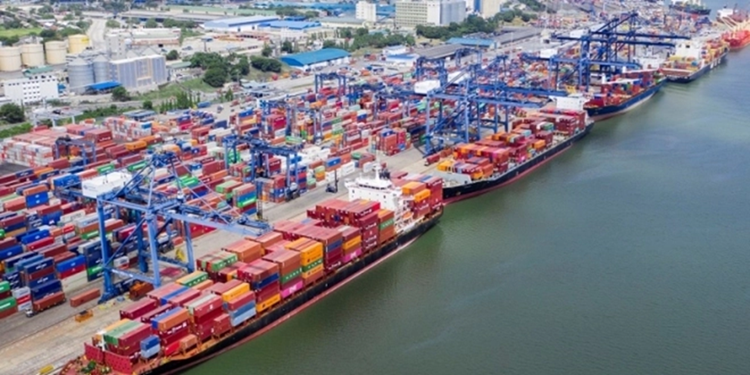
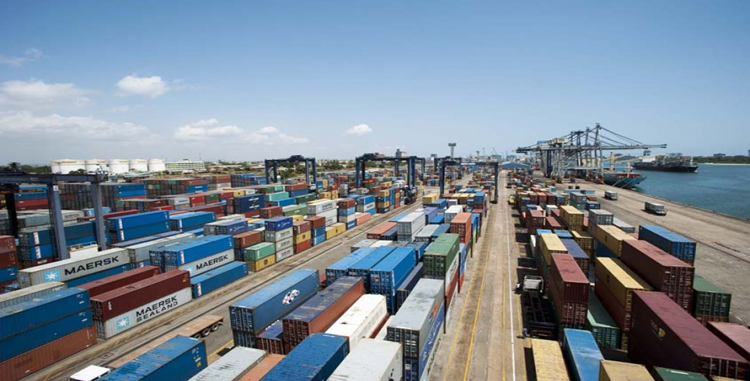
|
Facilities |
20 ft |
40 ft |
|---|---|---|
|
Container Facilities Available |
Yes |
Yes |
|
Container Freight Station (CFS) |
Yes |
Yes |
|
Refrigerated Container Stations |
Yes |
Yes |
|
Other Capacity Details |
N/A |
N/A |
|
Daily Take Off Capacity |
2808 |
|
|
Number of Reefer Stations |
438 |
|
|
Emergency Take-off Capacity |
N/A |
N/A |
|
Off take Capacity of Gang Shift |
N/A |
N/A |
Customs Guidance
The Tanzania Customs Integrated System (TANCIS) was introduced by the Tanzania Revenue Authority (TRA) in 2014. It has brought total transparency to the clearance process by handling all documentation online. The whole process can be carried out from the agent’s desk, leading to a significant time saving.
For more information on customs in Tanzania, please see the following link: 1.3 Customs Information.
Terminal Information
MULTIPURPOSE TERMINAL
The Multipurpose Terminal has a quay length of 797 meters and a total storage area of 222,000 square meters. It is equipped with modern cargo handling equipment, including cranes, forklifts, and reach stackers. The RORO Terminal has a quay length of 200 meters and a total storage area of 50,000 square meters. It is equipped with modern cargo handling equipment, including ramps and cranes. The terminal has a capacity of 200,000 vehicles per year. In 2022, the Multipurpose Terminal handled 14.1 million tons of cargo and the RORO Terminal handled 200,000 vehicles. These numbers are expected to grow in the coming years.
GRAIN AND BULK HANDLING
The Port of Dar es Salaam has a fully automated grain handling facility with silos with the capacity of 30,000 metric tons. Grains can be discharged and bagged along the quay at an average of more than 2,000 tons in 24 hours or transferred to silo using dump trucks. The grain terminal has concrete silos, fumigation, aeration and temperature control facilities. The break-bulk section of a port has a quay of 1,478 meters comprising of 7 main quays. The machinery available for grain discharge are 4 x bagging machines with capacity of 100 tons per hour each and a maximum of 9600 tons per 24 hrs
MAIN STORAGE TERMINAL
The Dar es Salaam Port has a variety of storage facilities, including warehouses, silos, and tanks. The port has a total of 10 warehouses with a combined area of 64,463 square meters. Of these warehouses, 3 warehouses are specifically dedicated to the storage of food supplies. These warehouses have a combined area of 21,500 square meters as well as silos which can store up to 30,000 tonnes of grains.
|
Storage Type |
Number of Storage Facilities |
Area (m2) |
|---|---|---|
|
Bagged Cargo |
8 |
|
|
Refrigerated Cargo |
438 |
|
|
General Cargo |
Stevedoring
TPA provides stevedoring for all geared vessels on a 24-hour basis. The shift performance on general cargo is 200 tonnes per gang per shift and 60 TEU on containerised cargo per gang per shift (TPA Handbook 2020)
Stevedoring activities at Dar es Salaam Port:
- General cargo, loading and unloading of non-containerized cargo,
- Containerized cargo, loading and unloading of containerized cargo.
- Bulk cargo, loading and unloading of bulk cargo, such as grain, coal, and minerals.
Hinterland Information
The primary means of accessing the hinterland from the port of Dar es Salaam are via the national road and two rail networks.
Road Network
The main road link from the Port of Dar es Salaam to the rest of Tanzania is the A7 highway. This highway connects the port to the capital city of Dodoma, as well as to other major cities such as Mwanza, Arusha, and Mbeya. The A7 highway is also a major transit route for goods traveling to and from neighbouring countries such as Zambia, Malawi, Rwanda, Burundi, and DR Congo.
Other important road links from the Port of Dar es Salaam include:
- The A14 highway to Tanga – Horohoro Border crossing - Kenya
- The B1 highway to Morogoro – Dodoma- Isaka-Mwanza-Mtukula-Uganda, and Rusumo- Rwanda-DR-Congo.
- The B12 highway to Iringa – Mbeya- (Tunduma- Zambia) and Malawi
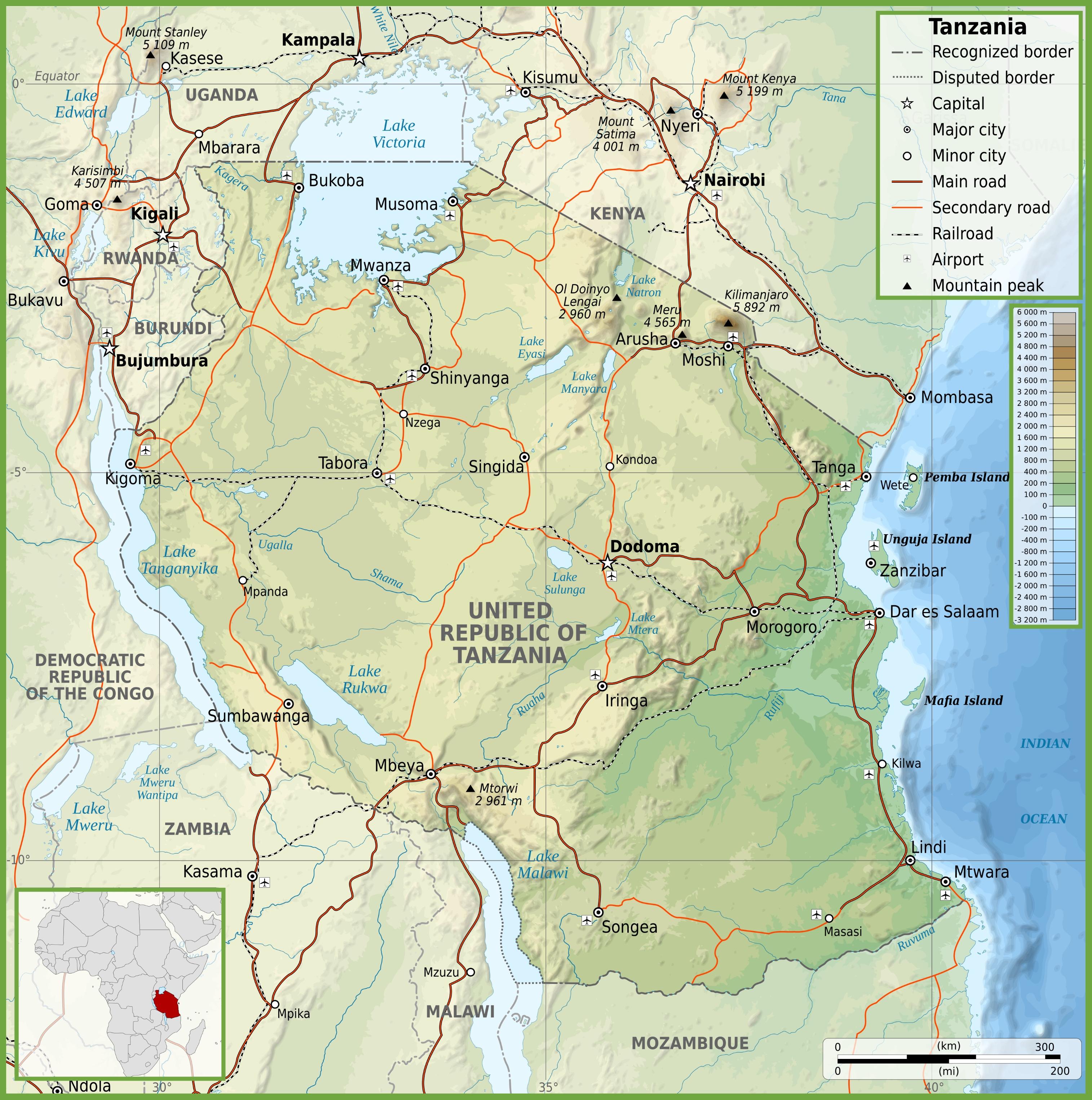
Rail links
The Port of Dar es Salaam is also connected to the rest of Tanzania and neighbouring countries by a network of railways.
TAZARA. This railway connects the Dar port to the Zambian capital of Lusaka, through Regions in Tanzania such as Pwani, Morogoro, Makambako, and Mbeya.
TRC: (the Central Corridor) is another important railway link from the Port of Dar es Salaam to the neighbouring countries of Uganda via Mwanza and DR Congo via Kigoma:
- The Central Line from Dar Port to Tabora, Mwanza, Katavi (Mpanda) and Kigoma
- The Northern Line from Dar Port to Tanga, Kilimanjaro and Arusha.
Port Security
The Port of Dar es Salaam has several security measures in place to protect the port and its cargo from crime and terrorism. These measures include Physical security of the port by a high fence with several security gates with all visitors required to have a valid pass. Employees of the port and other authorized personnel must wear ID badges. The port is also patrolled by security guards 24 hours a day. The port has invested in electronic security with number of CCTV cameras and other electronic security systems in place to monitor activity within the port.
All cargo entering or leaving the port is scanned for contraband and other threats. The port works closely with the Tanzania Police Force and other law enforcement agencies to combat crime and terrorism. The port implemented an Integrated Security System (ISS) which was commissioned in late 2015 to integrate all the port's security systems into a single platform to improve the efficiency and effectiveness of the port's security operations. The port is also investing in cybersecurity measures to protect its computer systems and networks from cyberattacks.
|
Security |
|
|---|---|
|
ISPS Compliant |
Yes |
|
Current ISPS Level |
ISPS Level 1 1 |
|
Police Boats |
Yes |
|
Fire Engines |
Yes |
2.1.2 Tanzania Port of Mtwara
Port Overview
Mtwara port is one of the three major ports managed by Tanzania Ports Authority, located 578 kilometers south of the Commercial city of Dar es Salaam. The harbor at the Port of Mtwara was deepened in the year between 1948-1954. The railway line was built to connect the port, as part of the Tanganyika groundnut scheme. Due to the failure of the scheme the port immediately lost value and the railway line was removed. The port was functional but underutilized for many years due to poor transport infrastructure. In the years of 2010-2011 the increased activity in oil and gas exploration activity caused a surge on operations of this port.
The port is one of the key components of the Mtwara Development Corridor project, which aims to develop the commercial exchange between Tanzania and its southern neighboring countries: Zambia, Malawi and Mozambique. The project includes an improvement of the road networks, port infrastructures and ease the border crossings process by implanting One Stop Border Post (OSBP) at the main entry points.
Port website: https://www.ports.go.tz/index.php/en/ports/mtwara
Key port information may also be found at: http://www.maritime-database.com
|
Port Location and Contact |
|
|---|---|
|
Country |
Tanzania |
|
Province or District |
Mtwara Region |
|
Nearest Town or City with Distance from Port |
Mtwara |
|
Port's Complete Name |
The Port of Mtwara |
|
Latitude |
-10.26833333 |
|
Longitude |
40.19777778 |
|
Managing Company or Port Authority |
TPA |
|
Management Contact Person |
The Port Master, Tanzania Ports Authority (TPA) |
|
Nearest Airport and Airlines with Frequent International Arrivals/Departures |
Julius Nyerere International Airport (Dar es Salaam) |
Port Picture
Quay of 385 length, which could accommodate 2 ships.
Description and Contacts of Key Companies
For more information on port contacts, please see the following link: 4.4 Tanzania Port and Waterways Company Contact List.
Port Performance
Mtwara Port can handle 400,000 MT of imports and exports per annum. The port is mainly designed to handle conventional cargo. That said, Mtwara Port attracts investors over the last years. TPA evaluates that the port could handle up to 750,000 MT with the same number of berths but if additional equipment are put in place for handling containerized traffic. (TPA, 2017)
|
Seasonal Constraints |
||
|---|---|---|
|
Occurs |
Time Frame |
|
|
Rainy Season |
n/a |
|
|
Major Import Campaigns |
n/a |
|
|
Handling Figures for 2018 |
|
|---|---|
|
Vessel Calls |
n/a |
|
Container Traffic (TEUs) |
No |
|
Handling Figures Bulk and Break Bulk for 2018 |
|
|---|---|
|
Bulk (MT) |
400,000 MT |
|
Break bulk (MT) |
|
Discharge Rates and Terminal Handling Charges
For information on port rates and charges, please see the following link: https://www.ports.go.tz/index.php/en/tariff-book. The rates applied at the port are established by TPA.
Berthing Specifications
|
Type of Berth |
Quantity |
Length (m) |
Maximum Draft (m) |
Comments |
|---|---|---|---|---|
|
Conventional Berth |
1 |
385 m |
9.85 m |
Can accommodate 2 ships and one coastal vessel |
|
Container Berth |
n/a |
|
||
|
Silo Berth |
n/a |
|
||
|
Berthing Tugs |
1 |
|
||
|
Water Barges |
n/a |
|
The port has a quay wall of 385 meters which can accommodate two
ships and one coastal vessel at a time. The draught is 9.85 meters
and with the introduction of new and more reliable solar powered
navigational aids, the port will be accessible to ships during 24
hours. (MCJURO, 2017)
General Cargo Handling Berths
|
Cargo Type |
Berth Identification |
|---|---|
|
Imports - Bagged Cargo |
n/a |
|
Exports - Bagged Cargo |
n/a |
|
Imports and Exports - RoRo |
No |
|
Other Imports |
Port Handling Equipment
The port equipment is managed by the government through TPA.
|
Equipment |
Available |
Total Quantity and Capacity Available |
Comments on Current Condition and Actual Usage |
|---|---|---|---|
|
Dockside Crane |
n/a |
||
|
Container Gantries |
n/a |
||
|
Mobile Cranes |
Yes |
3 |
1 x 25 MT, 1 x 50 MT and 1 x Mobile Harbour Crane of 100 MT |
|
Reach stacker |
Yes |
2 |
2 x 45 MT each |
|
RoRo Tugmaster (with Trailer) |
n/a |
||
|
Grain Elevator with Bagging Machines |
n/a |
||
|
Transtainer |
n/a |
||
|
Forklifts |
Yes |
8 |
3 MT, 5 MT and 16 MT |
Cargo handling equipment include 1 Mobile Harbour Crane 100 MT, 2 Reach Stacker 45 MT each, 1 Front Loader 42 MT, 2 Mobile Cranes 50 and 25 MT, 3 Empty Handler, 8 forklifts 16 MT, 5 MT and 3 MT, 6 Terminal Tractors, 2 Hoppers and 4 Grabs. Marine crafts available at the Port are 1 Tug Boat and 1 Mooring Boat. Mtwara Port is well equipped and prepared to handle all categories of cargo. They are working for 24 hours seven days of the week. (TPA, 2017)
Container Facilities
|
Facilities |
20 ft |
40 ft |
|---|---|---|
|
Container Facilities Available |
Yes |
Yes |
|
Container Freight Station (CFS) |
n/a |
n/a |
|
Refrigerated Container Stations |
n/a |
n/a |
|
Other Capacity Details |
n/a |
n/a |
|
Daily Take Off Capacity |
20 TEUs depending on transport |
n/a |
|
Number of Reefer Stations |
n/a |
n/a |
|
Emergency Take-off Capacity |
n/a |
n/a |
|
Off take Capacity of Gang Shift |
n/a |
n/a |
Customs Guidance
The customs process is usually done within 48 hours, if the documents are ready. The Surface and Marine Transport Regulatory Authority (SUMATRA) is responsible of the custom regulation. The customs clearance office is located in the port area and the working hours are the same as the other administrative activities of port authority.
For more information on customs in Tanzania, please see the following link: 1.3 Tanzania Customs Information.
Terminal Information
Multipurpose Terminal
n/a
Grain and Bulk Handling
n/a
Main Storage Terminal
There are four transit sheds with a total storage capacity of about 15,000 tons.
Available Storage at the terminal:
- Covered: One shed 2,500 m3
- Open air: 93,750 m3
|
Storage Type |
Number of Storage Facilities |
Area (m2) |
|---|---|---|
|
Bagged Cargo |
n/a |
|
|
Refrigerated Cargo |
n/a |
|
|
General Cargo |
4 |
Stevedoring
Stevedoring activities are provided by TPA and mainly include the wharfage and the lifting of the containers.
Hinterland Information
n/a
Port Security
|
Security |
|
|---|---|
|
ISPS Compliant |
Yes |
|
Current ISPS Level |
1 |
|
Police Boats |
No |
|
Fire Engines |
No |
Tanzania, United Republic of - 2.1.3 Port of Tanga
Port Overview
The Port of Tanga is one of the three (3) main Ports on the coast of the Indian Ocean, under the Tanzania Ports Authority (TPA); established in accordance with the Port Law No. 17 of 2004. The TPA is responsible for operating the Ports located in the lakes and development of all Ports in Tanzania to harness the geographical opportunities of the country of Tanzania to serve the neighbouring countries with access to international maritime trade. Tanga Port has a total of 400 Hectares of which 17 Hectares is where the current Port is located, recent improvements made by TPA to the Port of Tanga include strengthen two piers and increasing the length to 450 meters, with a depth of 13 meters (chart datum) these infrastructural improvements have increased the Port of Tanga currently cargo handling capacity to handle up to 3,000,000 tons per year.
The port has a rail siding connecting the port to the northern rail corridor which stretches from Dar es Salaam to Arusha and connects to the central rail corridor providing rail access to the ports Kigoma on lake Tanganyika and Mwanza on lake Victoria.
The improvements to the port infrastructure, good rail and road transport links to the hinterland and the low volume of maritime traffic provide a good alternative to avoid waiting time at Dar es Salaam port for importation to Tanzania, Uganda, Rwanda, Burundi, and DRC.
Key port information may also be found at: http://www.maritime-database.com
|
Port Location and Contact |
|
|---|---|
|
Country |
Tanzania |
|
Province or District |
Tanga |
|
Nearest Town or City with Distance from Port |
Tanga DISTANCE 1 km |
|
Port's Complete Name |
The Port of Tanga |
|
Latitude |
-5.065556 |
|
Longitude |
39.10583 |
|
Managing Company or Port Authority |
Tanzania Ports Authority (TPA) |
|
Management Contact Person |
Mr. Masoud Mrisha Port Manager Tanga Port P.O Box 443 Tel. +255 27 264 3078 Mob. +255 78 75 68 695 |
|
Nearest Airport and Airlines with Frequent International Arrivals/Departures |
Airport Name: Kilimanjaro International Airport Air Excel Air Tanzania Air Kenya Express Discover Airlines Edelweiss Air Ethiopian Airlines Flex flight Kenya Airways KLM Net jets Oman Air Qatar Airways Rwanda Air Safari link Aviation Turkish Airlines Uganda Airlines |
Port Picture
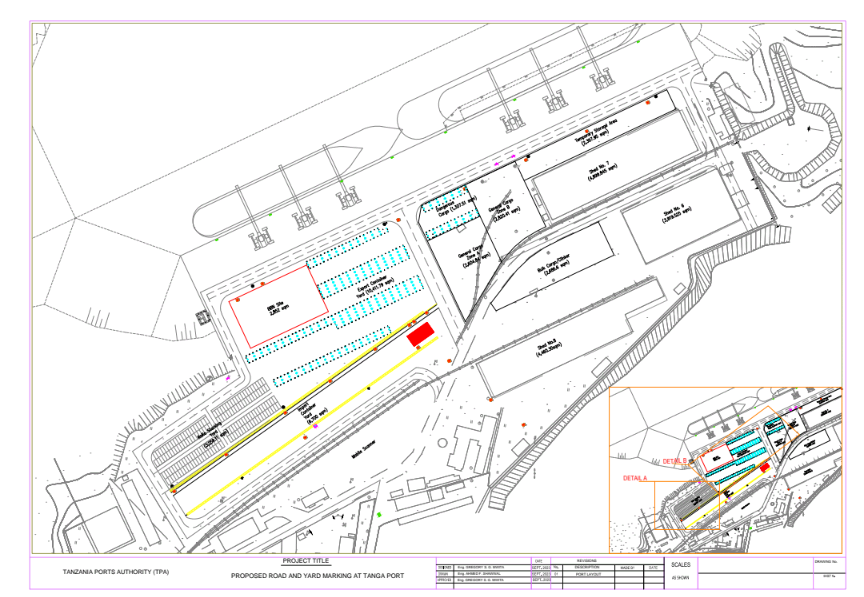
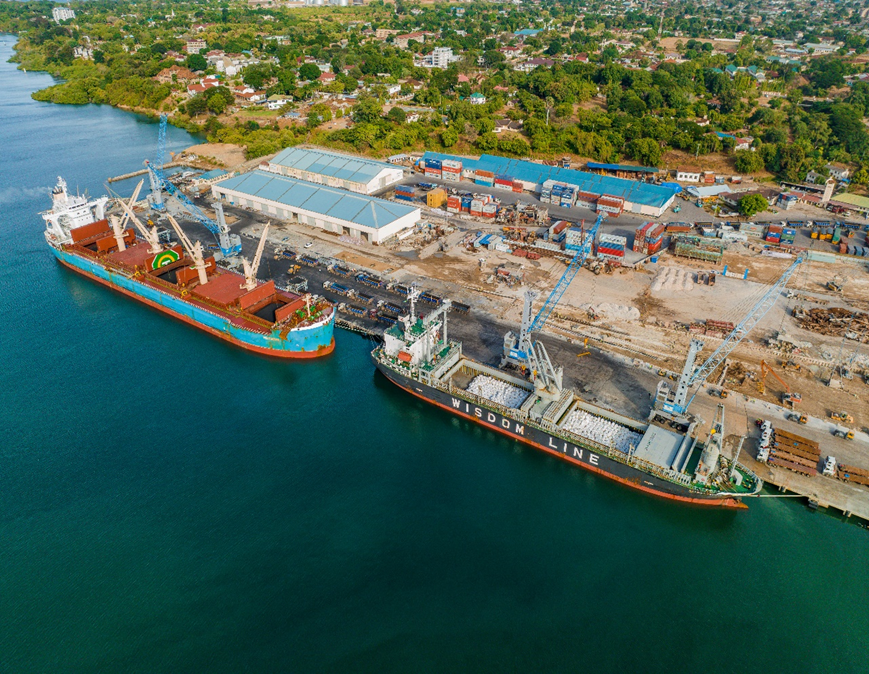
Description and Contacts of Key Companies
The port of Tanga has several companies shipping companies, clearing and forwarding companies and transportation companies they include Diamond Shipping Service Ltd, Inchcape Shipping Service (T) Limited, Nyota Tanzania Limited (Maersk) CMA CGM (T) Limited, and Sturrock Flex Shipping Company Limited, these companies provide logistics services at the Port. These companies play a crucial role as significant customers of the port, actively supporting and streamlining freight operations. Most of these companies have their offices situated within the TPA house, which is located within the port premises.
For more information on port contacts, please see the following link: 4.4 Port and Waterways Companies Contact List.
Port Performance
The port of Tanga has a modern quay wall with total length of 450 meters covering berths one and two. Currently there are two offshore pipelines with 12 inches are used for handling Liquid bulk (oil products). Also, at the Totten Island there is Conventional Buoy Mooring (CBM) for handling of Liquefied Petroleum Gas (LPG) by means of flexible hoses connected to submarine pipelines. Tanga Port is equipped with Harbour Mobile cranes with lifting capacity of 63 tons each, Tugboats, Cargo barges – each with capacity of 3,500 tons, Cargo Lighter with capacity of 600 tons, Pontoons for cargo transfer, Empty Container Handler – 12 tons capacity, Reach stackers for handling of full container with a capacity of 40 tons, Terminal tractor for longitudinal transfer of cargo, Forklifts with bale clamp attachment for handling of sisal fibres, 4 Standard Forklifts each with a capacity of 3,5, 16 and 25 tons, Terminal Tractors and Trailers, Fire Tender trucks equipped with firefighting equipment, Mooring Boat, Weighbridge for weighing cargo, Hoppers and Grabs for handling of bulk cargo.
|
Seasonal Constraints |
||
|---|---|---|
|
Occurs |
Time Frame |
|
|
Rainy Season |
Yes |
Mar - Jun Oct - Dec |
|
Major Import Campaigns |
No |
|
|
Other Comments |
Major export Campaigns Sisal - Coffee – Jul- Nov
|
|
|
Handling Figures Jul 2022-June 2023 |
|
|---|---|
|
Vessel Calls |
233 |
|
Container Traffic (TEUs) |
5,123 |
|
Handling Figures Bulk and Break Bulk for 2022 |
|
|---|---|
|
Bulk (MT) |
N/A |
|
Break bulk (MT) |
N/A |
Discharge Rates and Terminal Handling Charges
https://www.ports.go.tz/images/Reports/Tarrifbook/TPA-Tariff-Book_pub.pdf
Berthing Specifications
|
Type of Berth |
Quantity |
Length (m) |
Maximum Draft (m) |
Comments |
|---|---|---|---|---|
|
Conventional Berth |
2 |
450 |
13m |
Turning Basin 15-17 m |
|
Container Berth |
N/A |
|
||
|
Silo Berth |
N/A |
|
||
|
Berthing Tugs |
3 |
2 active, 1 on Maintenance |
||
|
Water Barges |
N/A |
|
General Cargo Handling Berths
|
Cargo Type |
Berth Identification |
|---|---|
|
Imports - Bagged Cargo |
1 & 2 |
|
Exports - Bagged Cargo |
1 & 2 |
|
Imports and Exports - RoRo |
N/A |
|
Other Imports |
Port Handling Equipment
TPA has invested in new port handling equipment in 2023 including 5 new mobile cranes, a new Transtainer crane/rubber-tyred gantry crane, new reach stackers and forklifts trucks.
|
Equipment |
Available |
Total Quantity and Capacity Available |
Comments on Current Condition and Actual Usage |
|---|---|---|---|
|
Dockside Crane |
Yes |
6 2 x 63 MT 4 x 100 MT |
5 Operational |
|
Container Gantries |
No |
||
|
Mobile Cranes |
Yes |
2 x 40 MT |
|
|
Reachstacker |
Yes |
3 x 45 MT |
|
|
RoRo Tugmaster (with Trailer) |
No |
||
|
Grain Elevator with Bagging Machines |
No |
||
|
Transtainer |
Yes |
1 |
New |
|
Forklifts |
Yes |
15 |
1 x 50 MT 1 x 25 MT 1 x 16 MT 7 x 5 MT 5 x 3 MT |
Container Facilities
Tanga port has 50 connection points for reefer containers, ample space beside the rail siding for storing standard shipping containers, with the addition of a new rubber-tyred gantry crane for loading trucks and rail carriages and good transport infrastructure from the port providing ease of access to the hinterland.
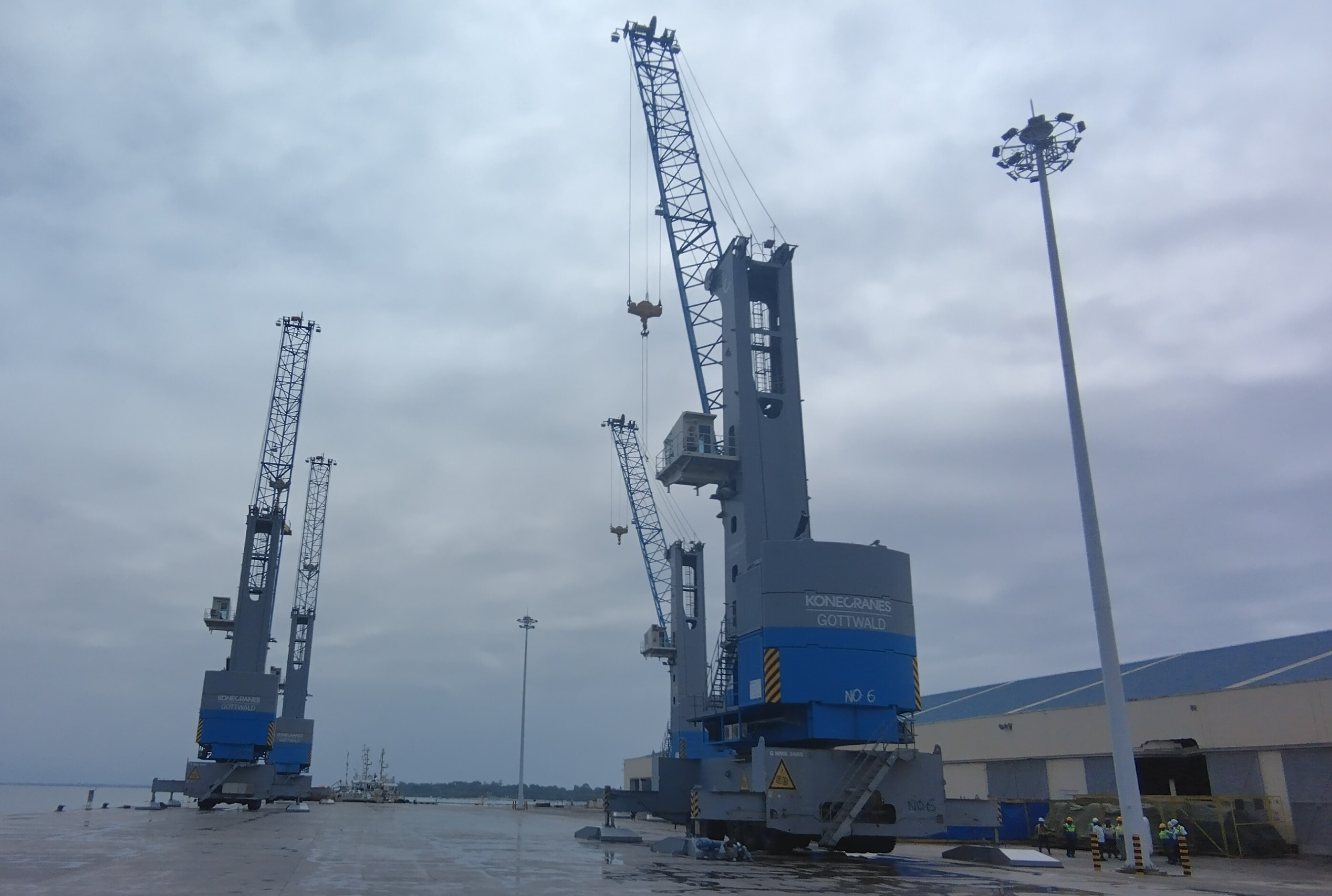

|
Facilities |
20 ft |
40 ft |
|---|---|---|
|
Container Facilities Available |
Yes |
Yes |
|
Container Freight Station (CFS) |
Yes |
Yes |
|
Refrigerated Container Stations |
3 |
|
|
Other Capacity Details |
||
|
Daily Take Off Capacity |
450 TEU per day |
|
|
Number of Reefer Stations |
50 |
|
|
Emergency Take-off Capacity |
N/A |
N/A |
|
Off take Capacity of Gang Shift |
150 TEU |
Customs Guidance
The volumes of cargo at the port are not high which also allows quick custom clearance completion. The customs offices are located nearby the port areas at TPA House operating at 24/7. The customs clearance process is done electronically through TANCIS. See link for process flow map of Customs clearance procedure at Tanga Port
https://www.ports.go.tz/index.php/en/customer-center/import-process
For more information on customs, please see the following link: 1.3 Customs Information.
Terminal Information
MULTIPURPOSE TERMINAL
The port has unused multipurpose Jetty, 12 anchorage berths and a lighterage quay of 3.8-meter draught for local craft. There are no available RoRo facilities exist at the port.
GRAIN AND BULK HANDLING
N/A
MAIN STORAGE TERMINAL
There are 3 sheds of 13,279.67 m2 with open conventional yard with paved area of 29,000m2 and stacking space for 4,300 TEUs.
|
Storage Type |
Number of Storage Facilities |
Area (m2) |
|---|---|---|
|
Bagged Cargo |
3 warehouses |
13,279.67 |
|
Refrigerated Cargo |
50 containers |
|
|
General Cargo |
1 |
2,604.84 |
Stevedoring
Stevedoring activities are provided by the port authority on a 24-hour basis.
Hinterland Information
The port of Tanga is connected to the Hinterland with good road and Rail access, the rail siding in the port area provides direct access to the Northern rail corridor to Kilimanjaro and Arusha and also links to the central Rail corridor in Dar es Salaam. The road network provides good access across northern Tanzania and into Kenya through three major one stop border posts.
Port Security
Port security at Tanga port is good, the port is fenced, and access is monitored, all visitors are recorded, badged and provided with Hi-Viz on entry. The gate to the port is manned 24/7, the port is patrolled by security personnel.
|
Security |
|
|
|---|---|---|
|
ISPS Compliant |
Yes |
|
|
Current ISPS Level |
1 |
|
|
Police Boats |
No |
4 TPA Security boat |
|
Fire Engines |
Yes |
|
Tanzania, United Republic of - 2.1.4 Port of Zanzibar
Port Overview
The port of Zanzibar, also referred to as the port of Malindi, is a deep-sea port located on the west coast of the island of Zanzibar and acts as the island’s main passenger and cargo port. The port of Zanzibar is managed, operated and developed by the Zanzibar Ports Corporation (ZPC), a parastatal organization established under the ZPC Act No.1 of 1997.The ZPC is regulated by the Zanzibar Maritime Authority, which focuses on safety, security, and tariff setting in the port of Malindi. The ZMA is a fully autonomous institution acting under the direct authority of the Zanzibar Ministry of Construction, Infrastructure, Communication, and Transportation.
Key port information can also be found at:
Port website: https://zpc.go.tz/
https://www.aglgroup.com/en/transport-logistics-africa/tanzania/
Key port information may also be found at: http://www.maritime-database.com
|
Port Location and Contact |
|
|---|---|
|
Country |
Tanzania |
|
Province or District |
Zanzibar |
|
Nearest Town or City with Distance from Port |
Stone Town 0 km |
|
Port's Complete Name |
Port of Malindi |
|
Latitude |
-6.161944 |
|
Longitude |
39.18833 |
|
Managing Company or Port Authority |
Zanzibar Port Corporation |
|
Management Contact Person |
Mr. Nahaat M. Mahfoudh, Director General ZPC Mr. Nicolas ESCALIN, CEO ZMT |
|
Nearest Airport and Airlines with Frequent International Arrivals/Departures |
Abeid Amani Karume International Airport, Stone Town, Zanzibar 10 kilometres away. International Carriers: Arkia Israel Airlines, Condor, Ethiopian Airlines, Fly540, flydubai, Israir, Kenya Airways, Malawian Airlines, Mango, Meridiana, Neos, Nordwind Airlines, Oman Air, Precision Air, Qatar Airways, Sun d'Or, Travel Service Airlines, TUI, Turkish Airlines. |
Port Picture
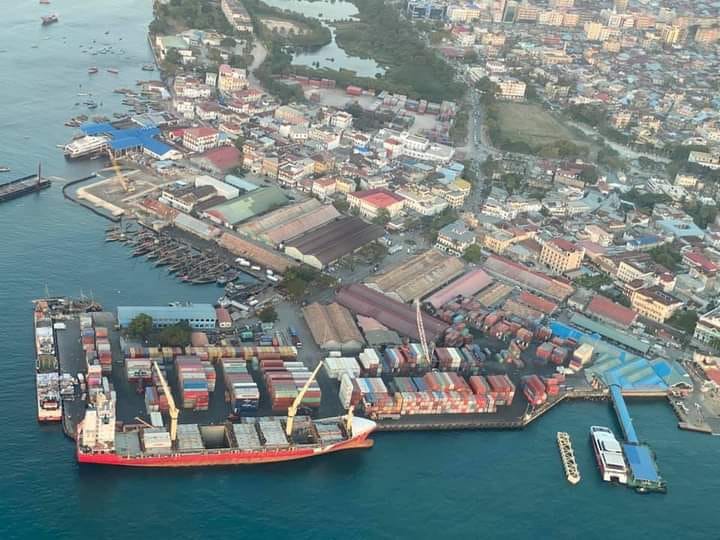
Description and Contacts of Key Companies
On May 18, 2023, the Zanzibar Ports Corporation (ZPC) and Africa Global Logistics (AGL) signed a five-year agreement for AGL to manage the container facility at the Port of Zanzibar. The agreement took effect on September 1, 2023. Zanzibar Multipurpose Terminal (ZMT), a subsidiary of AGL, officially began operations at the Malindi port on September 18, 2023. ZMT will provide cargo handling and maritime services at the islands main port. AGL has undertaken to implement an investment program for the modernization and development of the Port of Malindi. The company is planning to build an inland container depot (ICD) outside the port, The ICD will be located 3km north of the port at green field site located at Maruhubi (-6.142171497352352, 39.211110188527236) off the Malawi road, which is essential for relieving congestion at the port hub. ZMT is in the early stages of developing further modernization plans which include the future development dedicated container terminal at Nungwi in the north of the island.
For more information on port contacts, please see the following link: 4.4 Port and Waterways Companies Contact List.
Port Performance
The container terminal is heavily congested with no room for expansion within the port area. However, the change of management of the container facility is a significant event. Development of the inland container depot and removal of empty container will significantly alleviate congestion within the confines of the port. The agreement is expected to lead to improvements in the efficiency and productivity of the port, which will benefit all stakeholders, including shipping companies, cargo owners, and the people of Zanzibar with a reduction in ship dwelling times, improved cargo handling efficiency, increased container throughput, reduced costs for shipping companies and cargo owners and increased revenue for the ZPC.
|
Seasonal Constraints |
||
|---|---|---|
|
Occurs |
Time Frame |
|
|
Rainy Season |
Yes |
From March to June |
|
Major Import Campaigns |
No |
|
|
Other Comments |
|
|
|
Handling Figures for 2022 |
|
|---|---|
|
Vessel Calls |
130 |
|
Container Traffic (TEUs) |
75,000 |
|
Handling Figures Bulk and Break Bulk for 2022 |
|
|---|---|
|
Bulk (MT) |
N/A |
|
Break bulk (MT) |
N/A |
Discharge Rates and Terminal Handling Charges
Tariffs are set by Tanzania Ports Authority see link.
TPA-Tariff-Book_pub.pdf (ports.go.tz)
Berthing Specifications
|
Type of Berth |
Quantity |
Length (m) |
Maximum Draft (m) |
Comments |
|---|---|---|---|---|
|
Conventional Berth |
2 |
200 |
10 |
Berths 1 & 2 is used for both, mainly for discharge of containerised cargo. |
|
Container Berth |
|
|||
|
Silo Berth |
No |
|
||
|
Berthing Tugs |
Yes |
|
||
|
Water Barges |
No |
|
General Cargo Handling Berths
|
Cargo Type |
Berth Identification |
|---|---|
|
Imports - Bagged Cargo |
Mainly from Berth No 3 |
|
Exports - Bagged Cargo |
Mainly from Berth No 3 |
|
Imports and Exports - RoRo |
No |
|
Other Imports |
N/A |
Port Handling Equipment
Zanzibar Multipurpose Terminal (ZMT) currently has two mobile 75 tons mobile Harbour crane and a 20 tons Grove, plus a 5 tons Grove Crane. One of the 75 tons mobile crane was purchased in 2023 as part of the change of management in the Multipurpose Terminal.
|
Equipment |
Available |
Total Quantity and Capacity Available |
Comments on Current Condition and Actual Usage |
|---|---|---|---|
|
Dockside Crane |
No |
||
|
Container Gantries |
No |
||
|
Mobile Cranes |
Yes |
2 |
75 tons mobile Harbour crane and 20 tons Grove, plus a 5 tons Grove Crane |
|
Reachstacker |
Yes |
5 |
3 Kalmars 45 tons and 2 Ferraines |
|
RoRo Tugmaster (with Trailer) |
No |
||
|
Grain Elevator with Bagging Machines |
No |
||
|
Transtainer |
No |
||
|
Forklifts |
Yes |
7 |
3.5 tons to 7 tons and 16 tons capacity |
Container Facilities
As the port area is small and heavily congests ZPC have a container storage area located 260m from the port entrance used to store empty containers. Only empty containers are presently being stored in an open area marked in red which outside the harbour, the area is uneven and said to have a capacity for 2,000 TEU on a ground space of 26,400 m2, the area is on open ground with no fencing or security thus unsuitable for the storge of laden containers. 90% of all containers are stripped within the port area thus they do not leave the port area this has resulted in a build-up of empty containers in the port area. ZMT has plans to remove these

|
Facilities |
20 ft |
40 ft |
|---|---|---|
|
Container Facilities Available |
20 ft |
40 ft |
|
Container Freight Station (CFS) |
Yes |
Yes |
|
Refrigerated Container Stations |
2 |
|
|
Other Capacity Details |
No |
No |
|
Daily Take Off Capacity |
||
|
Number of Reefer Stations |
40 |
|
|
Emergency Take-off Capacity |
n/a |
n/a |
|
Off take Capacity of Gang Shift |
n/a |
n/a |
Customs Guidance
The customs process is usually within 48 hours if all documentation is correct. Zanzibar Maritime Authority (ZMA) is responsible enforcing custom regulation. There is a customs clearance offices located in the port area and the working hours are the same as administrative activities of port authority.
For more information on customs in Tanzania, please see the following link: 1.3 Customs Information.
Terminal Information
MULTIPURPOSE TERMINAL
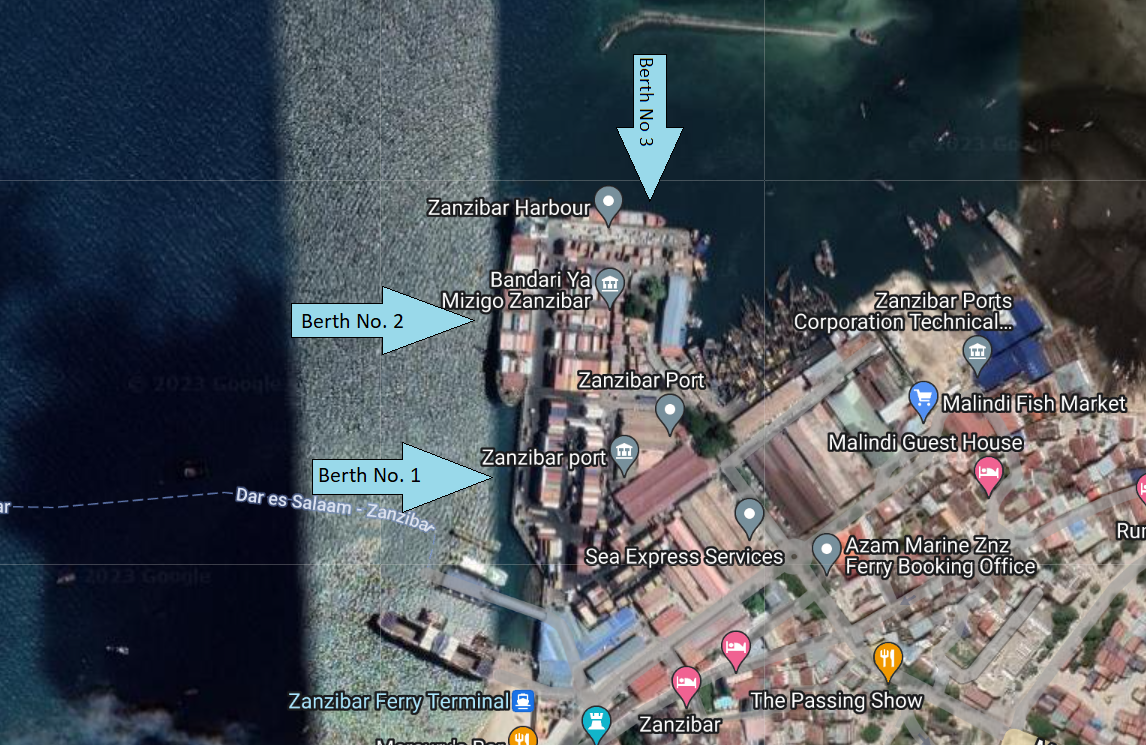
The port has one deep water quay with a length of 240 metres designated as berth No’s 1 & 2 with a draft is 10 meters. The port has a second smaller quay with a length of 125 meters designated berth No 3 with a depth of 9 meters, is used for cruise liners, passengers’ vessels, ferries and coasters carrying bulk cargo such as cement. Zanzibar Ferry terminal has a RoRo capacity for small ferries from the mainland. To the rear of the Container terminal is key for traditional Dhow sailing vessels used for fishing and transporting freight to smaller islands.
GRAIN AND BULK HANDLING
Bulk is discharged at berth 3 from small coasters from the mainland, berths 1 & 2 are normally used for container ships.
MAIN STORAGE TERMINAL
There is no storage within the perimeter of the port for bulk or break-bulk cargo. There are two port sheds that are used for the storage of imported motor vehicles. The quay for the imports of regional imports has limited customs shed space for the temporary storage of any items that are imparted from the region and are delayed pending final clearances. Import containers are stripped in ‘stacks‘ and the contents of the containers are loaded direct to road vehicles which then transport the customs cleared items out of the Port.
|
Storage Type |
Number of Storage Facilities |
Area (m2) |
|---|---|---|
|
Bagged Cargo |
N/A |
|
|
Refrigerated Cargo |
N/A |
|
|
General Cargo |
N/A |
Stevedoring
Stevedoring services are provided by ZPC at the ferry terminal and berth 3 for bulk cargo. ZMT now manage container cargo at the multipurpose terminal.
Hinterland Information
Transport out of the port is conducted by trucks around the island or by coasters and Dhow to smaller outlying Islands in the archipelago.
Port Security
All persons entering the port or working within the port area are badged, must ware Hi-Viz jackets and hard hats, security at the gateway has a strong presence and the entire port is fenced. ZMT has tightened up security at the Multipurpose terminal however, access by sea through the Dhow / Small craft jetty is a weak point in the overall security of the port area. This issue will improve when the ICD is opened and storage of contains is move to a more secure location.
|
Security |
|
|---|---|
|
ISPS Compliant |
Yes |
|
Current ISPS Level |
1 |
|
Police Boats |
Yes – One police marine boat |
|
Fire Engines |
Yes –fire station inside the port. |
Tanzania, United Republic of - 2.1.5 Port of Kigoma
Port Overview
The Port of Kigoma is a lake port located on the eastern shore of Lake Tanganyika in Kigoma, Tanzania. It is the largest port on Lake Tanganyika and plays a vital role in the country's trade and transportation sector. The port is owned and operated by the Tanzania Ports Authority (TPA).
The port has a single conventional berth with a length of 200 meters and a maximum draft of 5.5 meters. The port can handle a wide range of cargo, including breakbulk, and liquid goods. The port also has a dedicated liquid/oil reception facility.
The port's cargo handling equipment includes:
- Portal crane
- Forklifts
- Mobile crane
- Tug
- Weighbridge
The port also has two warehouses for the storage of cargo.
The port's main commodities handled include:
- Cement
- Fertilizer
- Steel
- Petroleum products
- Foodstuffs
The port is well-connected to the Tanzanian road and rail networks. The port is also connected to the neighboring countries of Burundi and the Democratic Republic of Congo and Zambia by ferry services.
The TPA is currently implementing several development projects at the Port of Kigoma, including the construction of a new container terminal and the rehabilitation of the existing berth. These projects are expected to increase the port's capacity and efficiency.
The Port of Kigoma is expected to play an increasingly important role in the trade and transportation of the East African region in the coming years. The port's strategic location on Lake Tanganyika makes it a key gateway to Burundi, the Democratic Republic of Congo, and Zambia. Overall, the Port of Kigoma is well-connected to the Tanzanian and regional transportation networks and handles a wide range of cargo.
Port website: https://www.ports.go.tz/index.php/en/ports/lake-tanganyika
Key port information may also be found at: http://www.maritime-database.com
|
Port Location and Contact |
|
|---|---|
|
Country |
Tanzania |
|
Province or District |
Kigoma |
|
Nearest Town or City with Distance from Port |
Kigoma (km) |
|
Port's Complete Name |
Port of Kigoma |
|
Latitude |
-4.876887 |
|
Longitude |
29.626428 |
|
Managing Company or Port Authority |
Tanzania Port Authority (TPA) |
|
Management Contact Person |
Mr. Eric B. Hamissi Managing Director +255 282503079 |
|
Nearest Airport and Airlines with Frequent International Arrivals/Departures |
Kilimanjaro International Airport (1,130Km)
|
Port Picture

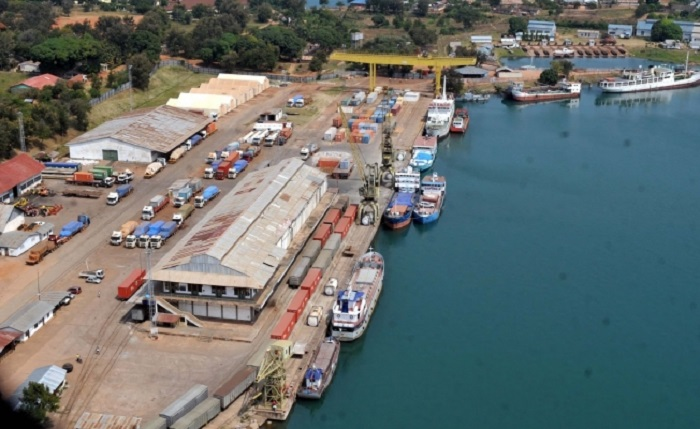
Description and Contacts of Key Companies
Marine Services Company Limited (MSCL) is the state-owned shipping company operating on the great lakes. MSCL has a fleet of 15 vessels for both Passengers and Cargo transportation. Nine (9) of these vessels are deployed on Lake Victoria, 3 on Lake Tanganyika and 2 on Lake Nyasa. The fleet is made up of 8 Passenger-Cargo vessels, 2 Oil Tankers, 1 Wagon Ferry, 1 Tug, 2 self-propelled barges and one tourist boat. MSCL signed contracts in October 2023 for the construction of new 3500-ton cargo vessel for operations on Lake Tanganyika, the vessel will have the capacity to load 25 long trucks or 25 modern railway wagons and 65 small cars. It will take six hours to travel from the Port of Kigoma to the Port of Kalemie in the Democratic Republic of the Congo (DRC).
There are several shipping agencies operating in Kigoma port including Falcony shipping, Shegema Company Ltd and Société Nationale des chemins de fer du Congo (SNCC) part of the Congolese Railway company.
For more information on port contacts, please see the following link: 4.4 Port and Waterways Companies Contact List.
Port Performance
Port traffic is light as there are a very limited number of vessels operating on Lake Tanganyika resulting in no waiting time and vessels are berthing on arrival. The draft of 5.5m is sufficient for the vessels currently operating on the lake. Container traffic is insignificant with annual container movements of around 300 per year.
|
Seasonal Constraints |
||
|---|---|---|
|
Occurs |
Time Frame |
|
|
Rainy Season |
Yes |
October to March |
|
Major Import Campaigns |
No |
N/A |
|
Other Comments |
||
|
Handling Figures for 2022/23 FY |
|
|---|---|
|
Vessel Calls |
531 |
|
Container Traffic (TEUs) |
300 |
|
Handling Figures Bulk and Break Bulk for 2022/23 FY |
|
|---|---|
|
Bulk (MT) |
|
|
Break bulk (MT) |
297,880 MT |
Discharge Rates and Terminal Handling Charges
TPA-Tariff-Book_pub.pdf (ports.go.tz)
Berthing Specifications
|
Type of Berth |
Quantity |
Length (m) |
Maximum Draft (m) |
Comments |
|---|---|---|---|---|
|
Conventional Berth |
3 |
100m 100m 210m |
3-5.5m |
|
|
Container Berth |
N/A |
|
||
|
Silo Berth |
N/A |
|
||
|
Berthing Tugs |
1 |
|
||
|
Water Barges |
N/A |
|
TPA with grant aid from the Government of Japan (JICA) have committed to a 5-year development plan for the port of Kigoma for the rehabilitation of this port. Under the “Project for Rehabilitation of Kigoma Port” contracts have been signed for rehabilitation of both the passenger wharf and the cargo wharf.
General Cargo Handling Berths
|
Cargo Type |
Berth Identification |
|---|---|
|
Imports - Bagged Cargo |
A-F |
|
Exports - Bagged Cargo |
N/A |
|
Imports and Exports - RoRo |
N/A |
|
Other Imports |
N/A |
Port Handling Equipment
The port is equipped with a mix of old and new handling equipment e.g., a Portal crane, Forklifts, Mobile crane, a Tug and a weighbridge. The handing equipment is owned and operated by Tanzania Port Authority.
|
Equipment |
Available |
Total Quantity and Capacity Available |
Comments on Current Condition and Actual Usage |
|---|---|---|---|
|
Dockside Crane |
Yes |
1 – 35 MT 2 x 5 MT |
1 of the 5 MT dockside cranes is unserviceable |
|
Container Gantries |
Yes |
1x 35 MT |
|
|
Mobile Cranes |
Yes |
1 x 60 MT |
|
|
Reachstacker |
yes |
1 x 45 MT |
|
|
RoRo Tugmaster (with Trailer) |
No |
||
|
Grain Elevator with Bagging Machines |
No |
||
|
Transtainer |
No |
||
|
Forklifts |
Yes |
7 x 3 MT 3 x5 MT 3 x 16 MT |
3 of the 3 MT forklifts are unserviceable 1 of the 16 MT forklifts is unserviceable. |
Container Facilities
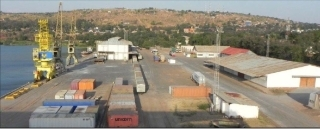
Container traffic at Kigoma port is very limited with only 300 container movement in the last year.
|
Facilities |
20 ft |
40 ft |
|---|---|---|
|
Container Facilities Available |
N/A |
N/A |
|
Container Freight Station (CFS) |
N/A |
N/A |
|
Refrigerated Container Stations |
N/A |
N/A |
|
Other Capacity Details |
N/A |
N/A |
|
Daily Take Off Capacity |
N/A |
N/A |
|
Number of Reefer Stations |
1 |
N/A |
|
Emergency Take-off Capacity |
N/A |
N/A |
|
Off take Capacity of Gang Shift |
N/A |
N/A |
Customs Guidance
The Tanzania Customs Integrated System (TANCIS) was introduced by the Tanzania Revenue Authority (TRA) in 2014. It has brought total transparency to the clearance process by handling all documentation online. The whole process can be carried out from the agent’s desk, leading to a significant time saving. The customs office in Kigoma port is operational 24/7, customs clearance for cargo precleared on TANCIS takes between 5 to 8 hours.
For more information on customs in Tanzania, please see the following link: 1.3 Customs Information.
Terminal Information
MULTIPURPOSE TERMINAL
The port of Kigoma has a terminal for loading and off-loading general cargo, containerized Cargo and Break-Bulk cargo. It has no RORO (Roll-on/Roll-off) facilities.
GRAIN AND BULK HANDLING
There is no grain and bulk handling facilities at the port since grains like maize are handled in break bulk bags by stevedores and cranes on pallets.
MAIN STORAGE TERMINAL
Storage at Kigoma port consists of 3 sheds with a total capacity of 10500 MT and 6 Mobile storage Units (MSU) belonging to World Food Programme with a total capacity of 2400 MT for storage of Humanitarian cargo bound for Democratic Republic of Congo and Burundi.
|
Storage Type |
Number of Storage Facilities |
Area (m2) |
|---|---|---|
|
Bagged Cargo |
3 6 x MSU for humanitarian cargo |
10500 MT 2400 MT |
|
Refrigerated Cargo |
N/A |
N/A |
|
General Cargo |
1 |
19840m2 |
Stevedoring
Stevedoring services are provided at the port by TPA utilising the service of Suma JKT Port and Services Co. Ltd. Suma JKT is part of the Ministry of Defence and National Service (MoDNS) the personnel are youth fulfilling Tanzanian mandatory national service requirements. Suma JKT Port and Services Co. Ltd is a company officially registered in 2020 with the aim of managing the loading and unloading of cargo at the port and ensuring the safety of goods entering and leaving the country. TPA have contracted Suma JKT Currently to coordinate and manage workers in all existing ports under the Tanzania Ports Authority (TPA) which are the ports of Dar es Salaam, Mwanza, Tanga, Mtwara, Kigoma, Kyela, Kasanga, Bukoba and Kemondo.
Hinterland Information
The port of Kigoma is connected to the Hinterland with good road and Rail access, the rail siding in the port area provides direct access to the Central rail corridor to Dodoma and Dar es Salam. The road network provides good access across northern Tanzania and into Burundi, Rwanda and Uganda through three major one stop border posts.
Port Security
Port security at Kigoma port is good, the port is fenced, and access is monitored, all visitors are recorded, badged and provided with Hi-Viz on entry. The gate to the port is manned 24/7, the port is patrolled by security personnel. There is also a police station 100m from the port entrance. Kigoma port conforms to Tanzania Shipping Agencies Corporation (TASAC) security regulations for Tanzanian inland ports.
|
Security |
|
|---|---|
|
ISPS Compliant |
No |
|
Current ISPS Level |
N/A |
|
Police Boats |
Yes |
|
Fire Engines |
No |
Tanzania, United Republic of - 2.1.6 Port of Mwanza
Port Overview
There are two ports in Mwanza city, Mwanza North port is primarily a passenger terminal Mwanza South Port is a cargo port, these ports located on the southern shore of Lake Victoria in Tanzania approximately 3 kilometres apart within the Mwanza city urban area. Mwanza is the largest port on the lake and plays a vital role in the country's trade and transportation sector. The port is owned and operated by the Tanzania Ports Authority (TPA).
Mwanza South Port has a single conventional Warf with a length of 280 meters divided into 3 berths with maximum draft of 5 meters. The port can handle a wide range of cargo, including breakbulk, bulk, and liquid goods. The port also has a dedicated liquid/oil reception facility. Mwanza South Port is well-connected to the Tanzanian road and rail networks. The port is also connected to the neighbouring countries of Kenya and Uganda by ferry services which include three rail ferry’s operated by Tanzania, Uganda and Kenya. These ferries provide a crucial intermodal link from Dar es Salam and Tanga ports to the ports of Kisumu in Kenya and Port Bell in Uganda.
Port website: https://www.ports.go.tz/index.php/en/ports/lake-victoria-respective-ports
Key port information may also be found at: http://www.maritime-database.com.
|
Port Location and Contact |
|
|---|---|
|
Country |
Tanzania |
|
Province or District |
Mwanza |
|
Nearest Town or City with Distance from Port |
0 km |
|
Port's Complete Name |
Mwanza Port South |
|
Latitude |
-2.535701 |
|
Longitude |
32.901259 |
|
Managing Company or Port Authority |
Tanzania Port Authority / |
|
Management Contact Person |
Mr. Erasto Lugenge; +255784761540 |
|
Nearest Airport and Airlines with Frequent International Arrivals/Departures |
Mwanza Airport (10km) |
Port Picture


Description and Contacts of Key Companies
Marine Services Company Limited (MSCL) is a Tanzanian company based in Mwanza. Prior to registration in 1997, MSCL was an integral part of Tanzania Railways Corporation (TRC). The company has more than 50 years of experience in maritime transport across Lakes Victoria, Tanganyika and Nyasa. MSCL services across the three lakes serves provide vital transport services to communities along the lakes and provides intermodal connectivity for the Northern and Central Corridors as well as East and Central African countries bordering the lakes. MSCL has a fleet of 15 vessels for both Passengers and Cargo transportation. Nine (9) of these vessels are deployed on Lake Victoria, 3 on Lake Tanganyika and 2 on Lake Nyasa. The fleet is made up of 8 Passenger-Cargo vessels, 2 Oil Tankers, 1 Wagon Ferry, 1 Tug, 2 self-propelled barges and one tourist boat. MSCL operate the Linkspan which allows rail freight carriages embark the 4 ships for passage across Lake Victoria. Each of the vessels has the capacity to embark 22 rail carriages.
MSCL currently construction a new vessel called MV Mwanza “Hapa Kazi Tu” with a capacity of 1,200 passengers and 400 tonnes of cargo which will be the largest vessel operating on Lake Victoria when it is commissioned in 2024.

MV Umoja, Tanzania

MV Uhuru, Kenya
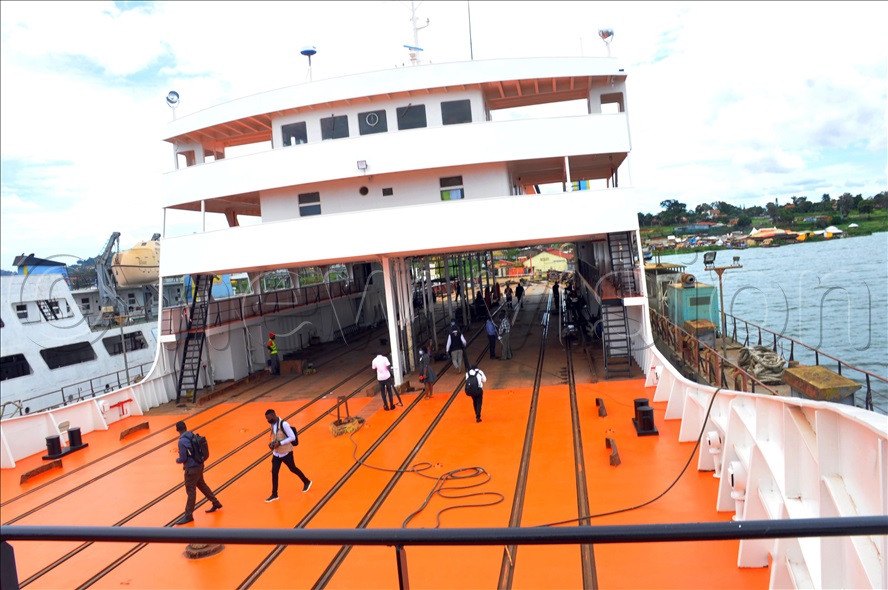
MV Pemba, Uganda
For more information on port contacts, please see the following link: 4.4 Port and Waterways Companies Contact List here.
Port Performance
The port of Mwanza has a channel draft and quay draft of 9 meters and 5 meters respectively. This is a great limitation to vessel size that can dock at the port. The port does not face any congestion problem and generally, the vessels are berthed on arrival. The construction of MV Mwanza “Hapa Kazi Tu” has blocked berth 1 for several years however the vessel is due to be commissioned in the first quarter of 2024 which will free up berth 1. when MV Mwanza “Hapa Kazi Tu” is operational this will add a new RoRo dimension to the terminal operations as the vessel will have capacity for 20 vehicles.
|
Seasonal Constraints |
||
|---|---|---|
|
Occurs |
Time Frame |
|
|
Rainy Season |
Yes |
From Oct to Dec and Mar to Jun |
|
Major Import Campaigns |
No |
|
|
Other Comments |
N/A |
|
|
Handling Figures for 2022/23 FY |
|
|---|---|
|
Vessel Calls |
2,341 |
|
Container Traffic (TEUs) |
N/A |
|
Handling Figures Bulk and Break Bulk for 2022/23 FY |
|
|---|---|
|
Bulk (MT) |
6000MT Coal |
|
Break bulk (MT) |
267,735.91 |
Discharge Rates and Terminal Handling Charges
SHIPPING FEES FOR SEABORNE CARGO DESTINED TO OR FROM TANZANIA
TPA-Tariff-Book_pub.pdf (ports.go.tz)
Berthing Specifications
|
Type of Berth |
Quantity |
Length (m) |
Maximum Draft (m) |
Comments |
|---|---|---|---|---|
|
Conventional Berth |
3 |
100m 100m 80m |
5m |
|
|
Container Berth |
N/A |
|
||
|
Silo Berth |
N/A |
|
||
|
Berthing Tugs |
1 |
|
||
|
Water Barges |
N/A |
|
The Mwanza North and south ports have a total warf length of 280m terminal and an Oil jetty.
The North port has one berth available for passenger traffic while the South Port has three berths available for cargo and passenger traffic.
- Berth 1 – 100m (cargo terminal),
- Berth 2 – 100m (passenger terminal),
- Berth 3 – 80m (passenger terminal)
- 10m berth for passenger terminal on the North Port.
https://www.ports.go.tz/index.php/en/ports/lake-victoria-respective-ports
Berths
|
Cargo Type |
Berth Identification |
|---|---|
|
Imports - Bagged Cargo |
1 |
|
Exports - Bagged Cargo |
1 |
|
Imports and Exports - RoRo |
N/A |
|
Other Imports |
Port Handling Equipment
The cargo terminal of Mwanza port south has a Portal crane, two forklifts, a mobile crane, a tug Linder, Weigh Bridge, Floating Dock and Dredger all operated by Tanzania Ports Authority (TPA).
|
Equipment |
Available |
Total Quantity and Capacity Available |
Comments on Current Condition and Actual Usage |
|---|---|---|---|
|
Dockside Crane |
No |
||
|
Container Gantries |
No |
||
|
Mobile Cranes |
Yes |
1 |
50mt capacity |
|
Reach stacker |
No |
||
|
RoRo Tugmaster (with Trailer) |
No |
||
|
Grain Elevator with Bagging Machines |
No |
||
|
Transtainer |
No |
||
|
Forklifts |
Yes |
2 |
1 x 3 mt, 1 x 5mt |
Container Facilities
|
Facilities |
20 ft |
40 ft |
|---|---|---|
|
Container Facilities Available |
N/A |
N/A |
|
Container Freight Station (CFS) |
N/A |
N/A |
|
Refrigerated Container Stations |
N/A |
N/A |
|
Other Capacity Details |
N/A |
N/A |
|
Daily Take Off Capacity |
N/A |
N/A |
|
Number of Reefer Stations |
N/A |
N/A |
|
Emergency Take-off Capacity |
N/A |
N/A |
|
Off take Capacity of Gang Shift |
N/A |
N/A |
Customs Guidance
Tanzania Revenue Authority (TRA) have a customs offices located at the port which operates on a 24/7 basis. The volumes of cargo transiting through the port are not high which makes for quick clearance and very short delays to transit times. Preclearance can be of cargo can be done online through the Tanzania Customs Integrated System (TANCIS) portal to minimise delays in customs clearance at the port of departure
For more information on customs in Tanzania, please see the following link: 1.3 Customs Information.
Terminal Information
MULTIPURPOSE TERMINAL
The multipurpose terminal at Mwanza port south includes a general cargo Warf with a total length of length of 280m an Oil jetty and a Linkspan. the South Port Warf is divided into Berth 1 – 100m (cargo terminal), Berth 2 – 100m (passenger terminal), Berth 3 – 80m (passenger terminal), The Linkspan connects the central rail corridor to rail ferries that operate across Lake Victoria from Tanzania to Port Bell, Uganda and Kisumu Port, Kenya. Three vessels have the capability attach to the Linkspan to embark 22 rail carriages for transport across the Lake.

GRAIN AND BULK HANDLING
Mwanza South port bulk cargo is mainly wood imported from Uganda the export of cement to Uganda. Ther port does not have facilities for bagging of bulk cargo as there is presently no demand.
MAIN STORAGE TERMINAL
Mwanza North port is the main Passenger terminal, upgrading of this terminal are due to commence in 2024 with the construction of a new terminal building. Mwanza South port is the primary cargo terminal with a rail siding in the port area, three storage sheds with 5691 m3 of covered storage and 3000 m2 of open storage available.
|
Storage Type |
Number of Storage Facilities |
Area (m2) |
|---|---|---|
|
Bagged Cargo |
1 |
5691.1 m3 |
|
Refrigerated Cargo |
N/A |
|
|
General Cargo |
1 |
3000m2 |
Stevedoring
All stevedoring services at both Mwanza port North and South are provided by Tanzania Port Authority.
Hinterland Information
Mwanza port South is connected to the hinterland via the Central rail corridor and road, Mwanza South port also provides the rail link to neighbouring countries across Lake Victoria for good shipped from Dar es Salaam and Tanga costal ports. This Rail/ Ferry link is vital for Uganda as a crucial trade link to and from the Indian Ocean.
Port Security
Tanzania Shipping Agencies Corporation (TASAC) is the regulatory authority for Tanzania inland waterways. TASAC is responsible for regulation of maritime administration, maritime environment, safety and security, the ports of Mwanza North and south comply with security level 1 under TASAC security requirements.
|
Security |
|
|---|---|
|
ISPS Compliant |
No. |
|
Current ISPS Level |
N/A |
|
Police Boats |
Yes |
|
Fire Engines |
Yes |

